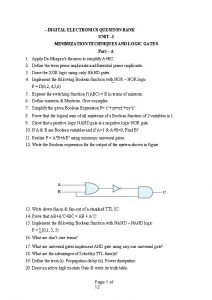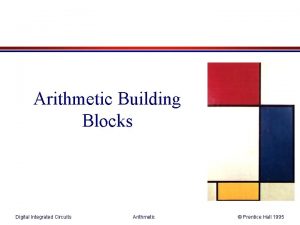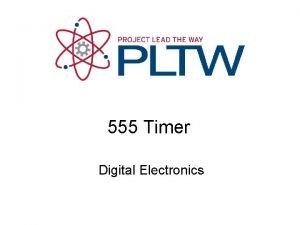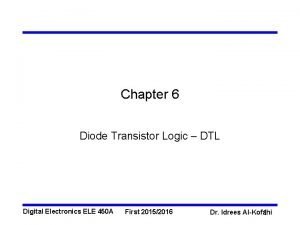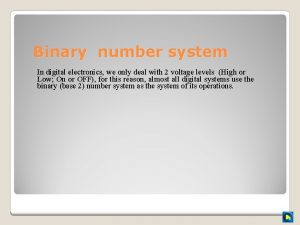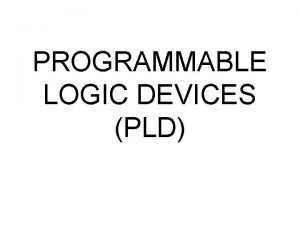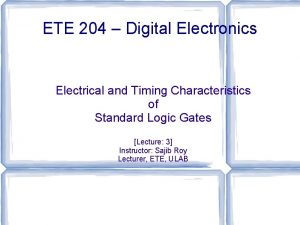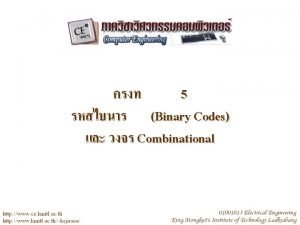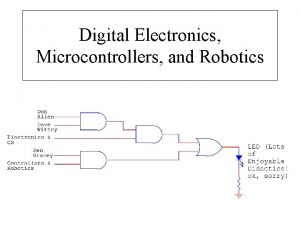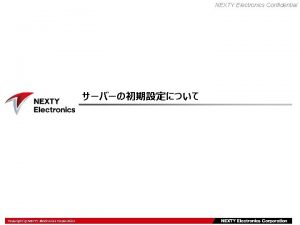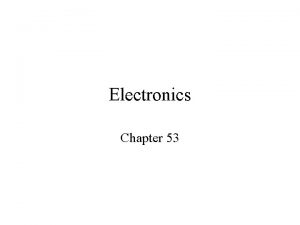Seven Segment Displays Digital Electronics Seven Segment Displays





































- Slides: 37

Seven Segment Displays Digital Electronics

Seven Segment Displays This presentation will demonstrate how… A seven-segment display can be used to display the decimal numbers 0 -9 and some alpha characters. 2

Seven Segment Displays This presentation will demonstrate how… A common anode 7 -segment display works. A common cathode 7 -segment display works. 3

Seven Segment Displays This presentation will demonstrate how… To select the resistor value for a 7 -segment display. 4

Segment Identification A Seven-Segment Display (SSD) is simply a figure eight grouping of LEDs (some include a decimal point or DP). a f b g c e d dp Each Segment is labeled (a) thru (g). 5

Segment Identification SSDs are available in two configurations: Common Cathode (all LED cathodes are connected) Common Anode (all LED anodes are connected) a f b g c e d dp 6

SSD Display Possibilities Decimal Digits 0 -9 7

SSD Display Possibilities Select Alpha Characters 8

SSD Display Possibilities Simple Messages 9

Basic LED Operations To Turn an LED ON. . . (+) ANODE • The ANODE must be at a higher voltage potential ( 1. 5 v) than the CATHODE. • The amount of current flowing through the LED will determine the brightness of the LED. • The amount of current is controlled by a series resistor. (not shown) ← Current Flow To understand how a seven-segment display works, we must review how an LED works. CATHODE (‒) 10

LED Configuration – Anode @ 5 Volts Switch @ 5 v LED Off Common Anode Configuration 5 v = Off 0 v = On 11

LED Configuration – Anode @ 5 Volts Switch @ 0 v LED ON, ANODE @ 5 V CATHODE @ 0 V (nearly) The 220 resistor controls the current. Common Anode Configuration 5 v = Off 0 v = On A larger resistor = less current = dim LED A smaller resistor = more current = brighter LED 12

Example #1: Common Anode SSD What value would be displayed in the common anode seven-segment display shown? 13

Example #1: Common Anode SSD What value would be displayed in the common anode seven-segment display shown? Solution: Common Anode: 0 volts = Segments On: b, c, f, & g 5 volts = Segment Off: a, d, & e What number is displayed? 14

Example #1: Common Anode SSD What value would be displayed in the common anode seven-segment display shown? a g f b c e d 15

Example #2: Common Cathode SSD What value would be displayed in the common cathode sevensegment display shown? 16

Example #2: Common Cathode SSD Common Cathode: 5 volts = Segment On: a, b, d, e, & g 0 volts = Segment Off: c&f 17

Example #2: Common Cathode SSD a g f b c e d 18

Resistor Values for SSD The resistor value determines the amount of current that is flowing through the LED in the SSD (Seven Segment Display). This is why they are sometimes called current limiting resistors. The amount of current determines how luminous (bright) the LED will be. 19

Resistor Values for SSD If the resistor is too large, the current will be too small and the LED will not be visible. If the resistor is too small, the current will be too large and the LED will be damaged. So, how do you select the correct value? You must read the data sheet for the SSD that you are using! 20

A Review of Circuit Theory The diagram below is a single segment of a common anode seven-segment display. The voltage across the LED (when on) is 1. 5 volts. ← I 21

A Review of Circuit Theory Using Kirchhoff's Voltage Law, we know that the voltage across the resistor is 3. 5 volts (5 v – 1. 5 v = 3. 5 v). Then, using Ohm’s Law, we can calculate the value of the resistor if we know the current that is to flow through the LED. ← I 22

Selecting A Resistor Value LTS-4801 JR Common Anode Seven-Segment Display Luminous Intensity vs. Forward Current Graph Let’s arbitrarily pick a luminous intensity of 1. 5 (not too bright, not too dim). From the graph, we need a current of 15 m. A. 23

Selecting A Resistor Value LTS-4801 JR Common Anode Seven-Segment Display Luminous Intensity vs. Forward Current Graph Apply Ohm’s Law Resistance = Voltage/Current R=V÷I 24

Selecting A Resistor Value LTS-4801 JR Common Anode Seven-Segment Display Luminous Intensity vs. Forward Current Graph Apply Ohm’s Law Resistance = Voltage/Current R=V÷I Voltage = 3. 5 V Current = 15 ma 25

Selecting A Resistor Value LTS-4801 JR Common Anode Seven-Segment Display Luminous Intensity vs. Forward Current Graph Apply Ohm’s Law Resistance = Voltage/Current R=V÷I R = 3. 5 V ÷ 15 ma (R = 3. 5 V ÷. 015 A) 26

Selecting A Resistor Value LTS-4801 JR Common Anode Seven-Segment Display Luminous Intensity vs. Forward Current Graph Apply Ohm’s Law Resistance = Voltage/Current R=V÷I R = 3. 5 V ÷ 15 ma (R = 3. 5 V ÷. 015 A ) R = 233 Ω (ohms) 27

Selecting A Resistor Value LTS-4801 JR Common Anode Seven-Segment Display Luminous Intensity vs. Forward Current Graph Nearest actual resistor value to 233 ohms: 220 Ω (ohms) 28

Example #3: Resistor Value Calculate the resistor value required to have a luminous intensity of 2. 5. 29

Example #3: Resistor Value Calculate the resistor value required to have a luminous intensity of 2. 5. Solution: From the graph, we need a current of ? 30

Example #3: Resistor Value Calculate the resistor value required to have a luminous intensity of 2. 5. Solution: From the graph, we need a current of ? 31

Example #3: Resistor Value Calculate the resistor value required to have a luminous intensity of 2. 5. Solution: From the graph, we need a current of 25 m. A. 32

Example #3: Resistor Value Calculate the resistor value required to have a luminous intensity of 2. 5. Solution: Using Ohm’s Law, (R = V ÷ I) find resistor value: 33

Example #3: Resistor Value Calculate the resistor value required to have a luminous intensity of 2. 5. Using Ohm’s Law: R=V÷I R = 3. 5 V ÷ 25 ma 34

Example #3: Resistor Value Calculate the resistor value required to have a luminous intensity of 2. 5. Using Ohm’s Law: R=V÷I R = 3. 5 V ÷ 25 ma R = 3. 5 V ÷. 025 A 35

Example #3: Resistor Value Calculate the resistor value required to have a luminous intensity of 2. 5. Using Ohm’s Law: R=V÷I R = 3. 5 V ÷ 25 ma R = 3. 5 V ÷. 025 A Resistance = 140 Ω 36

Example #3: Resistor Value Calculate the resistor value required to have a luminous intensity of 2. 5. Using Ohm’s Law: R=V÷I R = 3. 5 V ÷ 25 ma R = 3. 5 V ÷. 025 A Closest standard value: 150 Ω 37
 Is a digital camera an electronic device
Is a digital camera an electronic device Setup time and hold time in digital electronics
Setup time and hold time in digital electronics Accumulator electronics
Accumulator electronics Digital vs analog video
Digital vs analog video Minimization techniques in digital electronics
Minimization techniques in digital electronics Memory expansion in digital electronics
Memory expansion in digital electronics Electronics component identification
Electronics component identification Advantage of boolean algebra
Advantage of boolean algebra System digital
System digital Asynchronous counter definition
Asynchronous counter definition Arithmetic building blocks
Arithmetic building blocks 555 timer calculations
555 timer calculations Programmable devices
Programmable devices Timing diagram for or gate
Timing diagram for or gate Digital electronics chapter 1
Digital electronics chapter 1 Weighted and non weighted codes
Weighted and non weighted codes De morgan law proof boolean algebra
De morgan law proof boolean algebra The dtl propagation delay is relatively
The dtl propagation delay is relatively Number system digital electronics
Number system digital electronics State machines digital electronics
State machines digital electronics Logic
Logic Multiplexer and demultiplexer in digital electronics
Multiplexer and demultiplexer in digital electronics The boolean expression
The boolean expression Analogue and digital electronics
Analogue and digital electronics Vhmax
Vhmax Complement in digital electronics
Complement in digital electronics Digital fundamentals 10th edition floyd
Digital fundamentals 10th edition floyd Example of binary to decimal number system
Example of binary to decimal number system Msi digital electronics
Msi digital electronics In digital electronics
In digital electronics Digital motor electronics bmw
Digital motor electronics bmw Aoi logic
Aoi logic Segment invasion plan
Segment invasion plan Arsitektur komunikasi satelit
Arsitektur komunikasi satelit Common anode ssd
Common anode ssd Seven segment display vhdl
Seven segment display vhdl 7 deadly sins and heavenly virtues
7 deadly sins and heavenly virtues Apakah yang dimaksud dengan warga digital
Apakah yang dimaksud dengan warga digital




